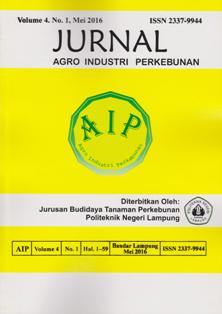Pengaruh Jenis dan Lama Penyangraian pada Mutu Kopi Robusta (Coffea robusta)
DOI:
https://doi.org/10.25181/aip.v4i1.34Abstract
The process of roasting the coffee beans will produce a good quality of taste and aroma. To conduct this research activity in the roasting researchers used a minimalist roaster machine (mini roaster). This study was conducted to determine the effect of temperature and duration of roasting, and the interaction of temperature and long roasting on the quality of Robusta coffee.The experiment was conducted in analysis laboratory, plant laboratory, and THP State Polytechnic of Lampung in November 2014 to February 2015. The experiments were performed with a patterned factorial randomized block design with 2 factors and each treatment combination was repeated 3 times. The first factor is the temperature which consists of three levels i.e. 190 oC, 200 oC, and 210 oC. The second factor is roasting duration wich consist of three levels i.e. 10 minutes, 16 minutes and 22 minutes. The results showed that the temperature 190 oC was the best in the roasting. Roasting duration 10 minutes was the best in the roasting process. Temperatures above 190 oC and duration above 10 minutes will reduce the quality of the coffee. The combination of the best treatment in the process of roasting seen from the middle value in the variable water content, juice coffee and caffeine levels are long roasting temperature of 190 oC and 10 minutes. Based on advanced testing methods Tukey confidence level of 95%, no interaction by the temperature and duration of roasting the coffee extract and the water content, but shows the interaction of the ash content and the caffeine content.Keywords: quality of Robusta coffee, roasting duration, roasting temperaturePermalink:Â http://jurnal.polinela.ac.id/index.php/AIP/article/view/34Downloads
References
Aulia, N. 2010. Pedoman Budidaya Tanaman Kopi. Bandung: Tim Karya Tani Mandiri.
Estiasih, Teti, dan K. Ahmadi. 2009. Teknologi Pengolahan Pangan. Bumi Aksara. Malang. https://id.wikipedia.org/wiki/Kopi. 2015. Ensiklopedia bebas. Wikipedia Bahasa Indonesia.
Rahayoe, S., J. Lumbanbatu, dan W. K. J. Nugroho. 2009. Pengaruh Suhu dan Lama Penyangraian terhadap Sifat Fisik-Mekanis Biji Kopi Robusta. Jurnal Penelitian. Yogyakarta: UGM.
Sivetz, M. dan H. E. Foote. 1963. Coffee Proccessing Technology. The Avi Publishing Company Inc, Connecticut.
Standar Nasional Indonesia. 1992. Kopi Instan, 01–2983–1992. Badan Standarisasi Nasional.
Standar Nasional Indonesia. 2004. Kopi Bubuk, 01–3542–2004. Badan Standarisasi Nasional.
Wahyuni, S. A. Rejo, dan Hasbi. 2008. Lama Penyangraian Terhadap Perubahan Karakteristik Biji Kopi dari Berbagai Daerah di Sumatera Selatan. Program Studi Teknik Pertanian Universitas Sriwijaya. Indralaya.
Yusdiali, W. 2008. Pengaruh Suhu dan Lama Penyangraian terhadap Tingkat Kadar Air dan Keasaman Kopi Robusta (Coffea robusta). Disertasi. Universitas Hasanuddin. Makasar.
Yuhandini, I., A. Rejo, dan Hasbi. 2008. Analisis Mutu Kopi Sangrai Berdasarkan Tingkat Mutu Biji Kopi Beras. Program Studi Teknik Pertanian Universitas Sriwijaya. Indralaya
Downloads
Published
How to Cite
Issue
Section
License
Authors who publish with Jurnal Agro Industri Perkebunan agree to the following terms:
Authors retain copyright and grant the Jurnal Agro Industri Perkebunan right of first publication with the work simultaneously licensed under a Creative Commons Attribution License (CC BY-SA 4.0) that allows others to share (copy and redistribute the material in any medium or format) and adapt (remix, transform, and build upon the material for any purpose, even commercially) with an acknowledgment of the work's authorship and initial publication in Jurnal Agro Industri Perkebunan.
Authors are able to enter into separate, additional contractual arrangements for the non-exclusive distribution of the journal's published version of the work (e.g., post it to an institutional repository or publish it in a book), with an acknowledgment of its initial publication in Jurnal Agro Industri Perkebunan. Authors are permitted and encouraged to post their work online (e.g., in institutional repositories or on their website) prior to and during the submission process, as it can lead to productive exchanges, as well as earlier and greater citation of published work.


























